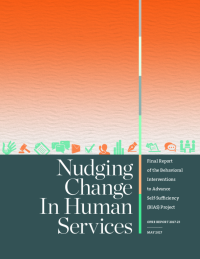Nudging Change in Human Services
Final Report of the Behavioral Interventions to Advance Self-Sufficiency (BIAS) Project
Research in behavioral economics has shown that small changes in the environment can make it easier for people to act and make decisions that support their goals. The Behavioral Interventions to Advance Self-Sufficiency (BIAS) project, launched in 2010, was the first major project to apply behavioral insights to the human services programs that serve poor and vulnerable families in the United States. The goal of the project — sponsored by the Office of Planning, Research and Evaluation of the Administration for Children and Families in the U.S. Department of Health and Human Services, and led by MDRC — was to learn how tools from behavioral science could be used to deliver program services more effectively and, ultimately, improve the well-being of low-income children, adults, and families.
Following a systematic approach called behavioral diagnosis and design, 15 state and local agencies participated in the project, which consisted of identifying problems that are appropriate for behavioral interventions, designing interventions, and conducting rigorous tests — where appropriate — to determine whether the interventions improved outcomes. The team launched 15 tests of behavioral interventions, involving close to 100,000 clients, in eight of the participating agencies. These tests spanned three domains: child support, child care, and work support. While each intervention was customized to fit its context, all involved at least one of the behavioral principles described by the “SIMPLER” framework, which stands for social influence, implementation prompts, making deadlines, personalization, loss aversion, ease, and reminders. Evaluated through randomized controlled trials, all BIAS sites had at least one intervention with a statistically significant impact on a primary outcome of interest. The magnitude of the improvements typically ranged from 2 to 4 percentage points (in line with other behavioral research findings) — but, in several cases, impacts were much larger. These impacts may be considered large relative to the costs for the interventions, which ranged from $0.15 per person to $10.46 per person.
The project’s findings suggest that small changes in, for instance, program outreach or the way that information is conveyed can help reduce some of the complexities that low-income populations face when they interact with human services agencies. While such “nudges” — defined as subtle and modest changes that help improve individual decision making — are shown to be an important aspect of the behavioral toolkit, the BIAS findings also suggest that it may be fruitful to extend the approach beyond program implementation to program design (at the local or state level) and policy formation (at the state or federal level). In this way, changes to program rules and agency practices may induce larger or longer-term changes in behavior among both clients and program staff.






